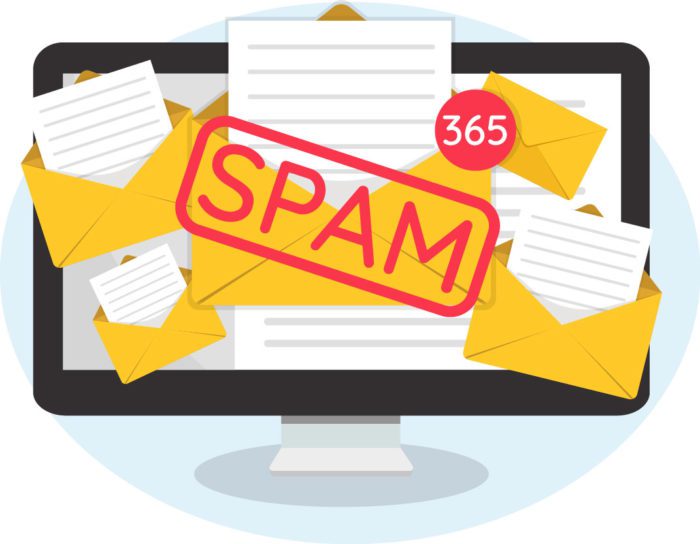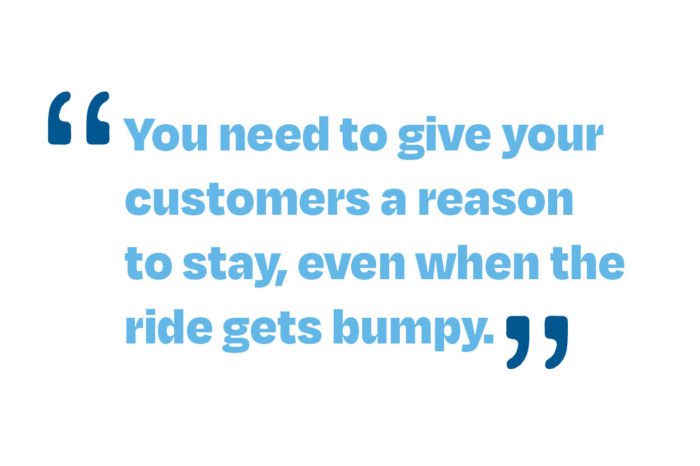When it comes to nurturing your prospects and customers, how much is too much communication? How much is too little?

With too much communication, people opt out and stop paying attention. With too little communication, you miss out on sales. Either your competition got to them before you did — or an existing customer leaves and goes to a competitor because they feel they don’t matter to your company. In short, having the wrong communication strategy costs you loads of money in one way or another.
Here’s an interesting side note: 69% of people claim they switched business providers because they felt the company didn’t care about them.
Crazy, right?
So with that in mind, how can you balance your frequency so there’s not too much communication or too little?
Communication Basics
How do you let your customers know that you care? Communication. But the issue isn’t just how much you communicate but also what you are communicating.
For example, have you ever taken a long trip with someone, and the two of you just talked the whole time — one topic of conversation flowing seamlessly to the next — and time flew by? Conversely, have you ever been on a long road trip with the kids and heard “Are we there yet?” at least a hundred times?
Comparing these vastly different road trips demonstrates that what you say is infinitely more important than the volume of content, so long as what you say is interesting and relevant to the person you’re talking to.
It’s also worth stating that not everyone finds everything interesting. One of your friends might like hearing about vintage cars for hours, while another friend might find that conversation incredibly boring. What you say needs to be tailored to match the interests of those you’re talking to.

Your timing and frequency are also important. Bombarding people with your content is never a good idea, even if it’s good content.
Think about it this way: On one hand, you might like to see your neighbor once a week, but if he was knocking on your door every 2 hours — even in the middle of the night — you’d be pretty upset. You definitely wouldn’t want to hear from him again, and you might even report him.
On the other hand, if you never saw your neighbor, you would have no relationship with him. You wouldn’t know his name and might not even notice if he moved away.
The same can happen with your content. You risk driving your customers away by sending too much, and you risk falling into obscurity when you’re too infrequent with your content.
But magical things can happen when the right content is distributed to the right person at the right time. You can forge relationships that last decades or even a lifetime. I’ve seen it work thousands of times for our clients, and let me tell you: It never gets old.

But how do you avoid becoming an annoyance while still consistently distributing awesome content?
Don’t Become Spam
How much content can you send every day, week, or month without annoying people? For email, you can typically send daily, with the occasional multiple emails in a single day. Many business owners feel that sending out a daily email is too much. I often hear, “I’d unsubscribe if someone sent me an email every day.”
The truth is that it doesn’t matter what you’d do. It only matters what your customers and prospects will do. You need to tailor your email schedule to their preferences.
And their preferences will vary heavily depending on the industry. Some industries can get away with emailing clients multiple pieces of content every day. With others, their audience will only want to hear from them once or twice a week.
To find your ideal schedule, you can ask your readers for their opinions on frequency. See if they would prefer daily emails, weekly emails, or something in between. Then, use that feedback to set your schedule and keep track of your campaign data. Over time, you can use the information you get from your open rates, spam rates, and more to tweak your strategy until it is perfect for your business.

Your emails also need to grab the reader’s attention right off the bat. Without snappy, interest-piquing copy, your email will be dead in the water, no matter how good the topics are.
If your open rates flop, you can be pretty sure that it has something to do with your subject line or tagline. That’s because your subject and taglines are the first things readers see before they even open your email. If those two don’t pass the sniff test, the whole email will likely get thrown in the trash.
So, if you are sending useful and entertaining information on an appropriate schedule, people will pay attention. (The exception to this rule is an event such as a webinar. You can send out three emails in a day: one containing information about the webinar, one announcing the start of the webinar, and one sending out a replay link).
The same goes for all types of media. If you create boring social media posts, you can post as often as you’d like and no one will care. Communication through social media platforms should be made often, be as interesting, relevant, and shareable as possible, and be competitive with other brands in your niche. So, keep up with other leaders in your industry and take inspiration from their pages.
From Inboxes To Mailboxes
Direct mail is an entirely different beast. With this type of communication, you can send out print marketing pieces as often as your budget allows. That being said, the same rules apply to direct mail as they do to email. If you’re constantly sending out boring content to your subscribers, you aren’t going to receive any responses.
For example, I received a postcard in the mail from a company that asked, “What do these 3 things have in common with the organization that sent this postcard?” When I eagerly flipped over the card to see the answer, it said, “Stay tuned until May 4 …”
What? Why would I want to eagerly await the answer to this question? Send me a postcard and make one single offer. It’s that simple.
Even if you sent a postcard like that daily, you’d never get a good enough response to justify the ad’s initial spending.
Imagine the success they would have had if they had planned their campaign out a little bit better.
A well-orchestrated print marketing piece has many unique benefits that digital media simply can’t beat. In fact, it was the amazing print newsletters I received from my area’s local businesses that inspired me to start Newsletter Pro in the first place. I could see that when done right, print marketing had the power to really stick with people and influence their opinions of a business.
But what makes print so special?
For one, print marketing is considered one of the most trustworthy forms of marketing. Not to mention that people tend to view print ads in a more positive light than digital ads.
It also provides a great way to stand out from the crowd. With many businesses (especially small-business owners) neglecting their print campaigns or giving up on them entirely, great print marketing really stands out.
But what should you even be sending your customers? What will resonate with them and give them a reason to be loyal to your business?
For starters, you can and should send birthday cards, special occasion cards, promotions or gifts, and audio-based content via CD or flash drive. These are branded items containing useful info about the industry. Of course, we shouldn’t forget a monthly print newsletter. That would be a tragedy.

When your campaign includes a variety of different print materials, you can be sure that you’re hitting your market from every angle.
How To Toe The Line
If you want a simpler answer to what counts as “too much communication” with prospects and clients, I’ll leave you with this thought: Nearly every company I look at — whether I’m looking to buy, invest, or become a mastermind member — 100% of them are under-communicating. Many of them are not communicating at all.
Instead of worrying that they are engaging in “too much communication,” they should be worrying that they’re not communicating enough.

I can’t tell you how many business owners have come to me privately and asked why their customers are leaving. My first question is always, “Well, what are you offering them besides your products and services?”
You would be amazed at how many of them were silent before finally telling me they didn’t know that was part of the deal. They thought they were just supposed to offer services in their industry, and that’s it.
How is that any different from what your competitors are doing?
It’s a dog-eat-dog world out there. If you aren’t building long-term relationships with your audience through valuable communication, you can forget about being an industry leader. In fact, you should be worried that any day, one of your competitors will undercut your pricing and eat your lunch.
For example, let’s say you have 3 friends. The first one only talks to you when they need you or when you’re directly in their line of sight. They don’t call you, they don’t text you, and they don’t invite you to dinner.
Your second friend only shows up once in a blue moon and always has a small gift for you. Your conversation isn’t great, but hey, at least they’re trying.
Your third friend consistently reaches out to you. They share things with you that you find valuable, like stories, funny videos, and educational information. You really like this friend’s personality and what they have to say. You can also count on them to reach out and express their appreciation for you on a regular basis.
Who are you going to be closer to?
Most people naturally gravitate toward a friend who is consistent with their communication. They might appreciate the friend who reaches out occasionally and is generous enough to give the occasional gift. Still, the relationship will never extend past the surface level.
The same goes for your business.
You need to give your customers a reason to stay, even when the ride gets bumpy. You simply can’t bribe your way into loyalty by using discounts, products, and services. You have to earn it through valuable communication.

So, my challenge to you is to determine how you can communicate more. What can you add? You don’t need to have a perfect communication strategy from day one, but you do need to start building up your touchpoints and their variety.
That’s because when it comes to communicating with your customers, you have to bring your A-game. Otherwise, it’s time to start planning for the day you finally lose them.
If you’re interested in learning more on this topic, you can fill out the form below to download your free copy of our Nurture Report.
About the Author: Shaun Buck is the CEO and founder of Newsletter Pro. In a little over a decade, he has been able to grow the business from a small newsletter company to a business that has serviced thousands of clients. To learn more about his story, you can check out our about us page here.


Recent Comments